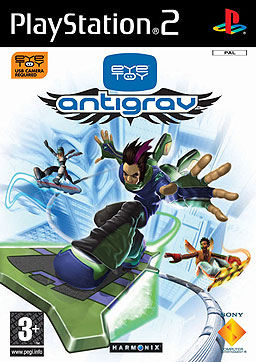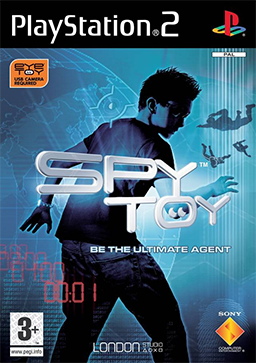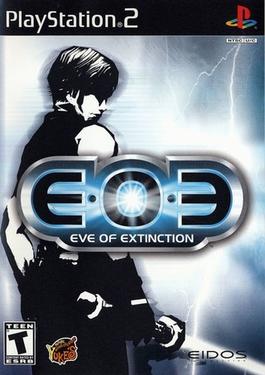
The EyeToy is a color webcam for use with the PlayStation 2. Supported games use computer vision and gesture recognition to process images taken by the EyeToy. This allows players to interact with the games using motion, color detection, and also sound, through its built-in microphone. It was released in 2003.

Sega Superstars is a party video game developed by Sonic Team for the PlayStation 2. It was published by Sega and released in Europe on October 22, 2004; in North America in November 2, 2004; and in Japan in November 11, 2004. The game features several minigames based on various Sega titles that are controlled using the EyeToy peripheral. Upon release, the game received "average" review scores from critics.

Need for Speed: Underground is a 2003 racing video game and the seventh installment in the Need for Speed series. It was developed by EA Black Box and published by Electronic Arts. Three different versions of the game were produced: one for consoles and Microsoft Windows, and another for the Game Boy Advance. An arcade version was additionally developed by Global VR, and was published by Konami with assistance from Electronic Arts.

EyeToy: Play is a minigame compilation video game for the PlayStation 2, released in 2003. It was the first game to make use of the PlayStation 2's video camera accessory, EyeToy. The game was initially packaged with the EyeToy when the accessory was first released.

EyeToy: Groove is a dancing game developed by London Studio and published by Sony Computer Entertainment. It was released on November 14, 2003 in Europe, on April 20, 2004 in North America, and on June 24, 2004 in Japan as EyeToy: FuriFuri Dance Tengoku. In EyeToy: Groove the player must hit targets with their arms on the edges of the screen to the beat of the music.

EyeToy: AntiGrav is a hoverboard game by Harmonix, released in November 2004 for the PlayStation 2. It was touted as the first "real" game for EyeToy targeted to more seasoned gamers. The earlier games such as Play and Groove were geared towards younger players for family or party fun. Unlike the earlier EyeToy games, the player's image is not shown inside the Antigrav game. Instead, the player's movement is reflected in the animated character in the game. The player moves their body to guide the on-screen character through a track. Some obstacles require the player to crouch or jump. Up to 4 players are supported. The game was released in the U.S. in November 2004, and in PAL in March 2005.

Formula One 05 is a racing video game developed by Studio Liverpool and published by Sony Computer Entertainment exclusively for PlayStation 2. It is a sequel to the 2004 video game Formula One 04 and was based on the 2005 Formula One World Championship.

EyeToy: Play 2 is the second PlayStation 2 game in the EyeToy: Play series. It uses EyeToy camera technology to project the player on to the television screen, allowing them to interact with on screen objects. The game contains twelve new minigames, that allow for single or multiplayer modes. The game also introduces a tournament mode, that allows several players to compete in a series of minigames, earning points for each game won.

Auto Modellista (アウトモデリスタ) is a racing game developed and published by Capcom, first released on PlayStation 2, later ported to GameCube and Xbox.

EyeToy: Kinetic is an exercise program, or exergaming title developed in collaboration with Nike Motionworks. It has been designed to help the player improve their fitness and health using a variety of exercise games.

EyeToy: Operation Spy is a PlayStation 2 game which uses the EyeToy camera peripheral to detect player movement.

EyeToy: Monkey Mania, also known as Saru Eye Toy Ōsawagi! Wakki Waki Game Tenkomori!! in Asia, Japan, and Korea, is a party game based on the Ape Escape franchise that requires the EyeToy camera peripheral to play. The game consists of the franchise's titular monkeys engaging in minigames, with multiplayer for up to four players. The title was sold as a standalone game, and also in a bundle with a silver-colored EyeToy peripheral.

Top Spin is a 2003 tennis video game developed by PAM Development and Indie Games and published by Microsoft Game Studios for the Xbox, later published by Atari Europe for PC in 2004 and by 2K for the PlayStation 2 in 2005. The game is a simulation tennis game in which players compete in singles and doubles matches, exhibition tournaments, and a career mode in which players develop skills and rise through the ranks of an international league. Featuring an expanded control scheme to its competitors, Top Spin features several innovations including 'risk shots', in which players can execute more difficult serves and shots in addition to flat, top spin, slice and lob swings.

EOE: Eve of Extinction is a beat 'em up video game developed by Yuke's and published by Eidos Interactive exclusively for PlayStation 2. The game features a man named Josh trying to save his girlfriend Elliel after she was transformed into a weapon called Legacy by the corporation known as Wisdom. The game was met with mixed reception, with reviewers praising the combat but criticizing the graphics and camera.

Army Men: RTS is a real-time strategy video game developed by Pandemic Studios and published by The 3DO Company for PlayStation 2, and Microsoft Windows. The GameCube version was published by Global Star Software, and developed by Coyote Developments. The game follows Sarge and his Heroes in the Green Army, as they fight the Tan Army across a variety of battlefields, over the course of 15 Campaign missions, 8 Special Operations missions and, 8 Great Battles. The Special Operations missions are absent from the PC release. The game was the final Army Men game from The 3DO Company. The Greenies hit dirt paths, linoleum floors and carpets and weave through flower beds, strewn boxes and toy train sets to collect plastic and electricity to build snipers to clear the field from afar or amass an army that overwhelms the opposition. The plot is loosely based on the movie Apocalypse Now, as the team of Green commandos must hunt down a rogue and apparently insane colonel, Colonel Blintz.
SingStar is a competitive music video game series for PlayStation consoles, developed by London Studio and published by Sony Computer Entertainment. Dozens of installments were released for the PlayStation 2, and several more for the PlayStation 3. It is also available on the PlayStation 4 as a free app download, with users paying for the songs as individual or bundle downloads. The games have also undergone a number of non-English releases in various European countries.

Constantine is an action-adventure video game developed by Bits Studios for PlayStation 2, Xbox and Microsoft Windows based on the DC Comics character John Constantine.

Toy Story 3 is a 2010 platform game developed by Avalanche Software and published by Disney Interactive Studios. The game is based on the 2010 film of the same name. It was released for PlayStation 3, Xbox 360, Wii, and Microsoft Windows. The game was ported to OS X by TransGaming. A Nintendo DS version was developed by n-Space, while Disney Mobile Studios developed and published an iOS game based on the film. Another version was developed by Asobo Studio and released for PlayStation 2 and PlayStation Portable.

Skylanders is a toys-to-life action-adventure video game series published by Activision. Skylanders games are played by placing character figures called the Skylanders on the "Portal of Power", a device that reads the figures' tags through NFC and "imports" the character represented by the figure into the game as a playable character.

The Playroom is a casual video game that is a collection of augmented reality mini-games. It was developed by Japan Studio's Team Asobi division, comes pre-loaded on all PlayStation 4 consoles, and is meant to demonstrate the use of the PlayStation Camera and the DualShock 4 controller. The PlayStation Camera accessory is required to play The Playroom. If a camera is not present, a trailer for The Playroom will be displayed instead of the full game. Firesprite, a studio founded by former employees of Studio Liverpool, worked on the visuals of The Playroom. Downloadable content is free.



















